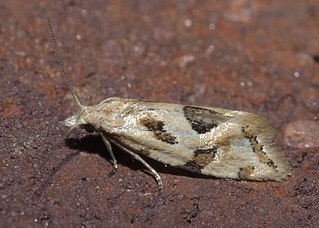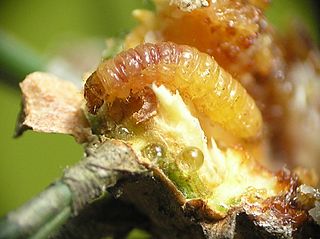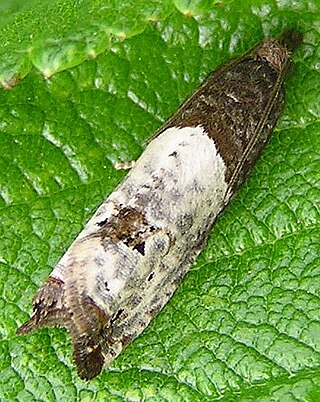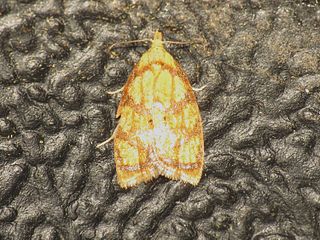
The Tortricidae are a family of moths, commonly known as tortrix moths or leafroller moths, in the order Lepidoptera. This large family has over 11,000 species described, and is the sole member of the superfamily Tortricoidea, although the genus Heliocosma is sometimes placed within this superfamily. Many of these are economically important pests. Olethreutidae is a junior synonym. The typical resting posture is with the wings folded back, producing a rather rounded profile.

Spilonota ocellana, the bud moth, is a moth of the family Tortricidae. It is found in the Palearctic realm, from North Africa and Europe to Iran, eastern Russia, China, Korea, and Japan. It is also present on Madeira and in North America.

Acleris is a genus of moths belonging to the subfamily Tortricinae of the family Tortricidae. As of 2007, about 241 species were known.

Aethes is a genus of moths belonging to the subfamily Tortricinae of the family Tortricidae.

Philedone is a genus of moths belonging to the subfamily Tortricinae of the family Tortricidae. It contains only one species, Philedone gerningana, the cinquefoil tortrix or cinquefoil twist, which is found in Asia and Europe. It was first described by the Austrian lepidopterists Michael Denis and Ignaz Schiffermüller in 1775.

Retinia resinella, the pine resin-gall moth, is a moth of the family Tortricidae.

Blastesthia turionella, the pine bud moth, is a moth of the family Tortricidae. It is found from Europe to eastern Russia, China, Korea and Japan. In the mountains, it occurs to elevations of up to 1,200 meters above sea level.
Epinotia rubiginosana is a moth of the family Tortricidae. It is found from Europe to eastern Russia, China, Korea and Japan.

Epinotia tenerana, the nut bud moth or alder tortricid, is a moth of the family Tortricidae.

Notocelia roborana is a moth of the family Tortricidae. It is found from Europe to eastern Russia. It is also found in Asia Minor, Iran, Mongolia and China (Xinjiang).

Notocelia cynosbatella is a moth of the family Tortricidae. It is found from Europe to eastern Russia, it is also found in Asia Minor, Iran, Kazakhstan, China and Mongolia.

Rhopobota naevana, the holly tortrix moth, holly leaf tier or blackheaded fireworm, is a moth of the family Tortricidae. It is found from Europe to eastern Russia, China, Taiwan, Mongolia, Korea and Japan. It is also present in India, Sri Lanka and North America.

Rhyacionia duplana, the summer shoot moth or Elgin shoot moth when referring to subspecies logaea, is a moth of the family Tortricidae. It is found from northern and central Europe to eastern Russia, China and Japan. It has also been reported from Korea, but it has not been found in recent studies.

Rhyacionia pinivorana, the spotted shoot moth, is a moth of the family Tortricidae. It is found from northern and central Europe to eastern Russia, China, Korea and Japan.

Zeiraphera ratzeburgiana, the spruce bud moth or Ratzeburg tortricid, is a moth of the family Tortricidae. It is found from northern and central Europe to eastern Russia and China. Zeiraphera ratzeburgiana is a taxonomically similar species to Zeiraphera canadensis and can only be distinguished by an anal comb found in Z. canadensis.

The Euliini are a tribe of tortrix moths.

Proteoteras aesculana, the maple twig borer, early proteoteras or maple tip moth, is a moth of the family Tortricidae. It is found from coast to coast in the northern United States, south to Mississippi in the east and to California in the west. It has a scattered distribution in Canada, from Nova Scotia to southern Alberta.

Clepsis senecionana, the rustic tortrix, is a moth of the family Tortricidae. It is found from Europe to eastern Siberia.

Acleris bergmanniana, the yellow rose button moth, is a moth of the family Tortricidae. It is found from most of Europe to the eastern Palearctic realm.

Proteoteras naracana is a moth of the family Tortricidae. It is found in North America, where it has been recorded from Alabama, Illinois, Indiana, Kentucky, Maryland, Massachusetts, Ohio, Pennsylvania, Tennessee, West Virginia and Wisconsin.



















